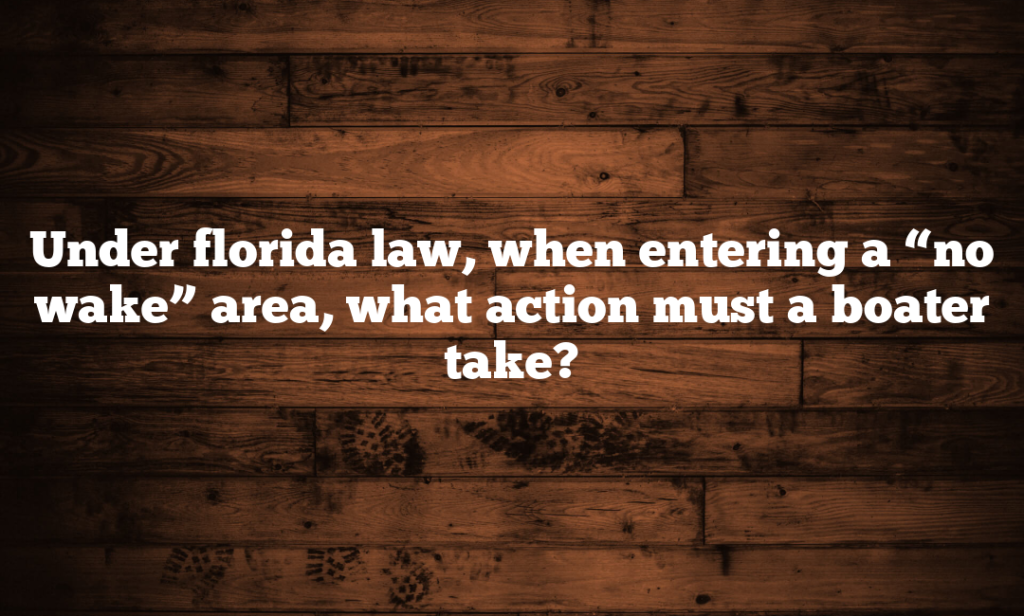Under florida law, when entering a “no wake” area, what action must a boater take?
Navigating Florida’s waterways can be an exhilarating experience, but it also comes with responsibilities, especially when encountering no wake zones. These designated areas are crucial for ensuring the safety of both boaters and the environment. In this guide, we’ll explore essential tips for boaters to navigate no wake zones effectively while adhering to Florida’s regulations.
Table of Contents
ToggleUnderstanding No Wake Zones
No wake zones are areas where boats must operate at a speed slow enough to create minimal wake. These zones are typically marked by signs, buoys, or other navigational aids. The primary purpose of no wake zones is to protect shoreline properties, wildlife habitats, and other vessels from the disruptive effects of boat wakes.
Importance of Compliance
Compliance with no wake zone regulations is essential for several reasons:
- Safety: Operating at excessive speeds in no wake zones can pose significant safety risks to other boaters, swimmers, and waterfront structures.
- Environmental Protection: Boat wakes can erode shorelines, damage vegetation, and disturb sensitive habitats. Adhering to no wake regulations helps preserve the natural environment.
- Legal Obligation: Violating no wake zone regulations can result in fines, penalties, and potential legal consequences. It’s crucial for boaters to understand and respect these regulations.
Essential Tips for Navigating No Wake Zones
1. Know the Signs
Before setting out on the water, familiarize yourself with the no wake zone signage used in Florida. Look for signs indicating the beginning and end of no wake zones, as well as any additional regulations or speed limits.
2. Reduce Speed Gradually
When approaching a no wake zone, begin reducing your speed well in advance to ensure a smooth transition to idle speed. Abrupt changes in speed can create unnecessary turbulence and disturb nearby vessels or wildlife.
3. Maintain Control
While operating at idle speed in a no wake zone, maintain control of your vessel at all times. Be prepared to adjust your course or speed as needed to avoid collisions with other boats or obstacles.
4. Stay Alert
Keep a lookout for other boaters, swimmers, and obstacles within no wake zones. Maintain situational awareness and be prepared to take evasive action if necessary.
5. Respect Shoreline Properties
Avoid approaching shorelines too closely in no wake zones, as boat wakes can cause erosion and damage to waterfront properties. Maintain a safe distance and be mindful of private docks, piers, and mooring fields.
6. Watch for Wildlife
No wake zones often coincide with areas of ecological significance, such as wildlife habitats and nesting grounds. Keep an eye out for wildlife, including birds, manatees, and other marine animals, and give them plenty of space.
7. Educate Passengers
Ensure that all passengers aboard your vessel understand the importance of no wake zones and the need to comply with regulations. Encourage everyone to enjoy the water responsibly and respect the environment.
8. Lead by Example
As a responsible boater, lead by example by following no wake zone regulations and demonstrating courtesy to other waterway users. Your actions can influence the behavior of others and contribute to a safer, more enjoyable boating experience for everyone.
Conclusion
Navigating no wake zones is a fundamental aspect of boating in Florida, requiring boaters to exercise caution, respect, and environmental stewardship. By understanding the importance of no wake zone regulations and following these essential tips, boaters can contribute to safer waterways and preserve the natural beauty of Florida’s aquatic environments. Remember, responsible boating benefits everyone—so let’s make a commitment to navigate no wake zones with care and consideration.

